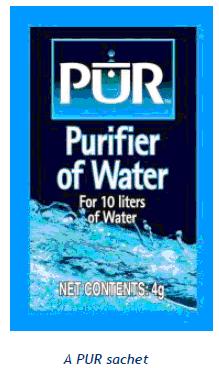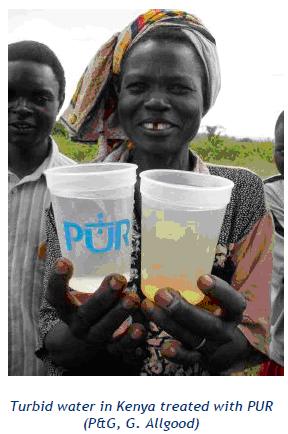PUR - Flocculant/Disinfectant
The Procter & Gamble Company (P&G) developed PUR Purifier of Water™ in conjunction with the U.S. Centers for Disease Control and Prevention. PUR sachets are now centrally produced in Pakistan, and sold to NGOs worldwide at a cost of 3,5 US cents per sachet. The PUR product is a small sachet containing powdered ferric sulphate (a flocculant) and calcium hypochlorite (a disinfectant). PUR was designed to reverse-engineer a water treatment plant, incorporating the multiple barrier processes of removal of particles and disinfection.
The flocculants/disinfectant powder PUR has been proven to remove the vast majority of bacteria, viruses, and protozoa, even in highly turbid waters. PUR has also been documented to reduce diarrheal disease from 16 to greater than 90% incidence in five randomized, controlled health intervention studies. In addition, PUR removes heavy metals, such as arsenic, and chemical contaminants from water. Studies showing the efficacy of PUR have been conducted in the laboratory and in developing countries, in rural and urban areas and refugee camps, and include adults and children that are poor and/or using highly turbid water.
History and social context
190 million sachets of PUR, treating 1,9 million litres of water, have been distributed in emergency response or old through social marketing projects in 2003-2009. PUR has been made available in over 55 countries with numerous partners using a variety of strategies. For distribution, P&G works with over 80 organizations such as PSI, CARE, World Vision, Aquaya Institute, USAID, the U.S. Centers for Disease Control and Prevention, the International Council of Nurses, Johns Hopkins University Center for Communication Programs, Save the Children, Samaritan's Purse and Americares.
Suitable conditions
PUR is most appropriate in areas with a consistent supply chain for sachet resupply and in urban, rural, and emergency situations where educational messages can reach users to encourage correct and consistent use. The product needs a distribution system to be successful.
| Advantages | Disadvantages |
|---|---|
| - Proven reduction of bacteria, viruses, and protozoa in water - Removal of some heavy metals and pesticides |
- Multiple steps are necessary to use the product, which requires a demonstration to teach new users - The need for users to have, employ, and maintain two buckets, a cloth, and a stirring device |
|
|
Construction, operations and maintenance
To treat water with PUR, users open the sachet, add the contents to an open bucket containing 10 litres of water (1 sachet of PUR is to treat 10 litres water), stir for 5 minutes, and let the solids settle to the bottom of the bucket, strain the water through a cotton cloth into a second container, and wait 20 minutes for the hypochlorite to inactivate the microorganisms.
PUR is packaged in child resistant packaging to prevent accidental ingestion by a small child
PUR is manufactured and tested in the laboratory and field by Procter & Gamble.
Estimated Lifespan
PUR sachets have a 3 year expiry date.
Costs
| Captial Cost | Operation Cost | Replacement Cost | Estimated 5 years Cost | Cost/liter treated |
|---|---|---|---|---|
| US$ 10 per unit | US$ 1 |
Each sachet of PUR is provided to global emergency relief organizations or non-governmental organizations at a cost of $0,035 (3,5 US cents), not inclusive of shipping from Pakistan by ocean container. Transport, distribution, education, and community motivation can add significantly to program costs. Sachets are generally sold at product cost recovery for 10 US cents each, for a cost of 1 US cent per litre treated. Currently, PUR projects operate either on partial cost recovery (charging the user only for the product, and subsidizing program costs with donor funds), or fully subsidized free distribution such as in emergency situations. Procter & Gamble sells the PUR sachets at cost, makes no profits on PUR sales, and donates programmatic funding to some projects.
Manuals, videos and links
- PUR Water Filtration and P&G's Children's Safe Drinking Water Program Take Jessica Biel, Kenna and Other Cultural Influencers to Meet Those Affected by the Clean Drinking Water Crisis Before Embarking on SUMMIT ON THE SUMMIT: Kilimanjaro. News article about the Children's Safe Drinking Water Program (CSDW).


